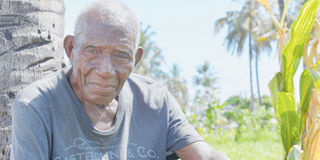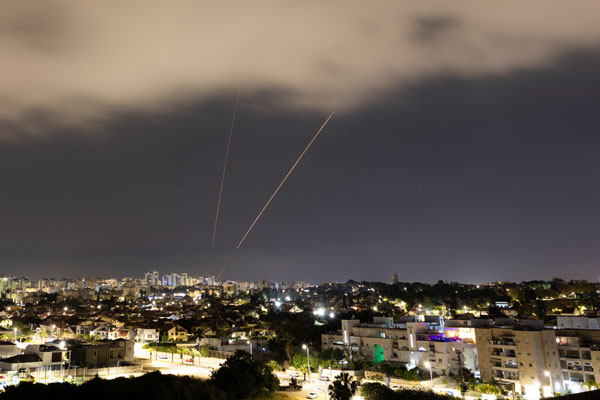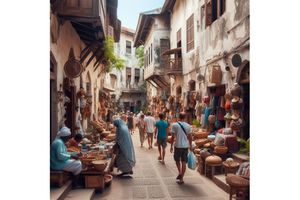The many faces of small scale Msimbazi farmers

Korbinian Remingus Kombe or Mzee Kombe has been working at Msimbazi as a farmer for the past 20 years now. Before that, he served in the Tanzanian Army up to 1985.
PHOTO | Hansjürg Jäger
What you need to know:
- With a knife, Mama Hawa, chops the strips from the amaranth bundles to equalise the length before arranging them in her plastic dish. She is then accompanied by two of her colleagues to go and sell at the neighbouring market. She waves goodbye.
Seated on her sandals, Mama Hawa who is in her late sixties, is preparing amaranth, a grain comparable to rice or maize, to be sold on the market later that day. She has kept apart the big bundle and carefully begins picking plants of the same size to make smaller bundles.
With a knife, Mama Hawa, chops the strips from the amaranth bundles to equalise the length before arranging them in her plastic dish. She is then accompanied by two of her colleagues to go and sell at the neighbouring market. She waves goodbye.
Mama Hawa alias Halima Ramadhani, has been working as a vegetable-vendor since her husband left her with the two kids, ten years ago. Mama Hawa gets up early every day, picks her belongings and goes to Msimbazi, where farmers grow spinach, amaranth, pumpkin, potatoes, beans, eggplants, tomatoes and more on small plots between large palm trees.
The Msimbazi fields are limited by Kigogo road in the north and the east, Uhuru street in the south and Nelson Mandela road in the west and stretches over a surface of more than 120 acres. It is home to many farmers and small scale businessmen and women like Mama Hawa.
There are so many people working
While Mama Hawa disappears into the city, Silvano and Silvestri sit on the edge of one of her pumpkin-fields. Both seem to be resting in the shed of the palm trees, the government planted in the late 1970’s. Silvano has been a practising farmer for over ten years now. Silvestri has more than 35 years of experience in farming on the small plots of Msimbazi. He has become a mwalimu (teacher), to many of the farmers in the fields. Upon asking about how many people he has already imparted his knowledge to, he laughs. “I don’t have a count but over the years, a lot of people have come in. I was lucky enough to help,” he says.
Silvano discovered farming or rather gardening by accident, as he’s an electrician by profession. Silvano and Silvestri share some insights on how the food is grown in Msimbazi before they depart for the city.
“We both work on a small plot, each farmer occupies an acre to cultivate his crops,” says Silvano. He learnt how to farm, like many others, by being on the fields. And it was Silvestri, who helped understand the science of the farming practise. “But there are also extension workers from the government, they help us with the application of fertilizers and some other agrochemicals,” Silvano explains. He continues, “Chemicals do help to grow vegetables better. If we would not use them, we wouldn’t have anything green on our plate.”
It is mainly urea and chicken-dung, the city-farmers need to keep their soils fertile; and some add composted bark to enhance the soil’s fertility.
Herbicides, insecticides and fungicides on the other hand do not find their way to Msimbazi, according to Silvano and Silvestri. And even if they do sometimes, it is not a concern. “You know, I have been working here for 35 years now. And I am still healthy and strong,” Silvestri says.
Five hundred meters away from Silvano and Silvestry is Mzee Korbinian Remingus Kombe’s plot. The short 81-years-old man has served as a Corporal in the Tanzanian Army until 1985. And it took him another ten years, until he started to grow some food in Msimbazi, which has become his bread-earner for the past twenty years.
The water is almost dead
While walking around Msimbazi, the translator adds something, which is an eye opener. “Some people believe that the farmers working here do use dead water. This water is neither clean nor safe to be used to irrigate fields. And this also means, that the products sold here are seen as unsafe and unfit for consumption.”
In the north and in the south, between the huts and the fields, small becks do carry a little water. These are cluttered with wastes, plastic-bags, plastic-bottles, residues from tissues and larger plastic containers. In addition, there are some waterholes between the fields. Both are essential to make the crops grow better under the Tanzanian sun. “Only in the rainy-season, we do have a problem,” Silvano says. With the rainfalls, the becks become rivers that flood the fields with garbage and excrements from the surrounding houses and spoil the waterholes at the field. Sometimes, if it rains too long, the water even floods Silvano’s house, which is just at the entrance of the Msimbazi city-fields.
In addition, there is some risk that the water itself is polluted by the farmers in the fields. The reason is the urea and the chicken-dung used to keep the soils fertile. While the first is the best source for nitrogen, the latter contains large amounts of phosphor. Plants do need both in order to grow well, but still there are some implications for the environment, which seemed not yet to be a real concern.
The nitrogen is best absorbed in cool climate and clay, or humus-rich soils, which do have a better capacity holding the water back. Sandy soils, heat and a lack of water does have a negative impact on the transformation of the nitrogen. The result is ammonia-emission, which do have adverse effects on the air.
Phosphor on the other hand is linked to water-pollution. First, if there is not enough phosphor, the growth of crops is heavily limited. Ensuring phosphorus supply in the fields is crucial to maintain the yields. But often, farmers tend to use too much phosphorus to be on the safe side. As phosphor is gradually transformed in aqueous systems, it remains long time in the rivers, lakes and even the ocean, before the cycle can be closed again. Thus, over time, it accumulates and stimulates the growth of some algae and other organisms.
And pesticides are out of reach for most of the farmers here. “Too expensive,” Silvano says. The fertilizers on the other hand are still available in less quantity though. “Chickens are slowly disappearing, and this makes it harder to find chicken-dung for our fields,” explains Silvano.
Upcountry produce paving ways into the Dar markets
Besides the problem with the water, there is little to worry about. The climatic conditions are favourable. “You know, we do not need to know exactly, at what time we have to plant which crop. It is just growing,” says the army-veteran Mzee Kombe as he rests his shoulders on the palm tree.
In the rainy season, farmers can plant and sow, grow and sell their produce day after day. “But if it rains too much, we need to wait,” Mzee Kombe explains. It is that moment, when the fields become too wet, meaning the roots of the plants do not get the oxygen needed to grow.
“For harvest, we wait until the vegetables reach a certain height and size. Then we cut it and sell it to the women coming here to resell,” Mzee Kombe adds.
On the other hand, business has become harder. “The life of farmers was better in former times. There were less people farming and growing vegetables. But now…,” Silvestri pauses. “But now, there are people from Morogoro and Dodoma who are growing food and bringing it to the city.
And this is not only crushing our prices, but also competing with our production,” he continues.
Most vegetables sold at Kariakoo, in the heart of Dar es Salaam are not delivered by Mama Hawa and her colleagues. Instead, trucks arrive to unload their freight everyday from Ruaha, Morogoro and Dodoma region.
Kasiani Zongo is one of the businessman from Kariakoo. He tells Sound Living, “You know, most of the farmers in Msimbazi do not use modern agricultural methods. And most of them have less than one acre.” According to him, Msimbazi is not productive enough to feed the growing population in the city. Even the salesmen in the less popular Tandale-market do not source their vegetables from the small-scale producers. Instead, the salesmen are going to Kariakoo and Ilala-market every morning to get their supplies.
Ramadhani Muhoma and his nephew own a small store where they sell carrots, green pepper, zucchetti, lime, eggplant, mango, chili, tomatoes and okra.
Ramadhani has been working as a vendor for the past 30 years now at the market and says that the carrots sometimes come from Nairobi and other places in Kenya.
While every day, vendors like Mama Hawa are visiting the farmers to get the freshest vegetables to sell, they cannot serve bigger sellers. And neither farmers can serve bigger salesmen in the city. But all of them do make a part of their living from selling crops from Msimbazi.




